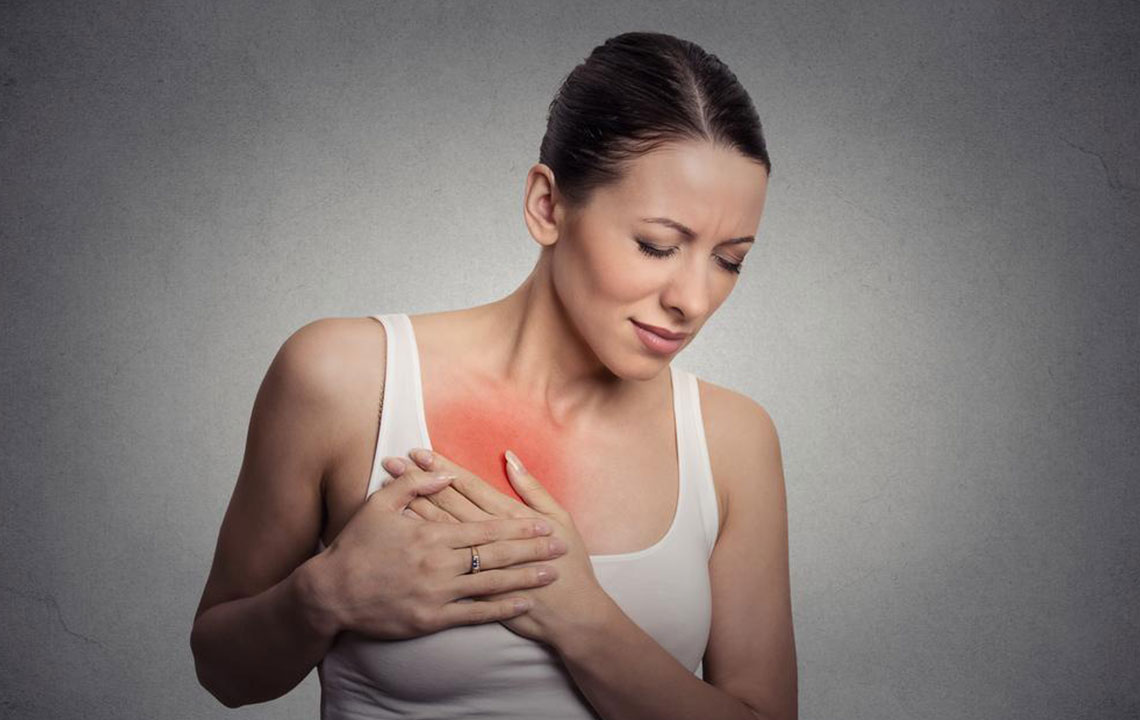All You Need to Know about Breast Pain

Left breast pain in women can often be a warning sign of a future heart attack or be an underlying symptom of other serious conditions.
Women tend to take these signs lightly, and in extreme cases, the result is death.
Left breast pain can be a major indicator of underlying health problems. The best way to figure out if you’re really in trouble is by learning how to identify the location of the breast pain. Pain can originate from bodily structures located in the area under the breast. This is why non-breast related issues also need to be taken seriously.
Heart attack symptoms may manifest as left breast pain, and this is an issue that is often overlooked amongst women. Common symptoms of oncoming heart attacks related to left breast pain include—a tightness in the chest, pain in the neck, jaw, or left arm, shortness of breath, sweating, nausea, dizziness, and a gut-feeling followed by a sense of uneasiness.
Causes of left breast pain in women
Let’s take a look at some of the common causes of left breast pain:
- Injuries
Injuries to the breasts, come with scar tissues and this can cause pain in those regions. The elastic layer protecting nerve endings is sensitive, and injuries to this layer can cause pain. - Surgeries
Surgeries related to the left breast can cause pain due to the development of scar tissues and fat necrosis. This takes time to heal, and pain is caused during this process. The healing of incisions due to augmentation, reduction, or reconstruction, can also lead to left breast pain. - Hormonal Imbalances
Hormonal changes or imbalances in the female body can lead to breast pain. This typically occurs during menstrual cycles, or if the woman is consuming hormonal pills or undergoing hormone replacement therapy. Taking certain oral contraceptives and infertility treatment procedures can also cause left breast pain in women. - Inflammation Or Lumps
Inflammation or swelling of the breast, due to underlying symptoms can cause breast pain. Also, the formation of lumps which are not related to menstrual cycles can cause pain in the breast. This kind of pain often requires a doctor’s call, and patients diagnosed with this condition need immediate treatment.
Non-breast related symptoms of left breast pain in women
Although left breast pain in women typically originates from the breast, sometimes the pain may come from underlying structures, which are not directly related to the breast.
Here are some of the common symptoms, and those that require immediate treatment:
- Pain in the chest walls due to high-stress levels or anxiety is another non-breast related symptom of left breast pain in women. Stretched chest muscles or injuries related to this area may also cause this pain.
- Gastroesophageal Reflux Disease can sometimes mimic left breast pain in women. A hiatal hernia can also contribute to this pain. Esophageal related pain can occur below the breast, and acidic sensation in the mouth are some of the attributable causes.
- Inflammation at the juncture of the rib cage and the sternum can lead to left breast pain in women.
- Pneumonia causes left breast pain since the lungs are located right below the breasts.
- Pulmonary emboli, or the clotting of blood vessels near the legs, which run up to the lungs, can cause a feeling or sensation of left breast pain in women.
- Skin-related conditions such as shingles, which develop on the surface of the skin, accompanied by rashes, can also cause breast pain in women.
When should you visit a doctor?
Left breast pain in women can be a delicate matter. Whether the pain originates from a simple, reversible condition like wounds and minor injuries, or if it’s something severe such as breast cancer or heart attacks, it is difficult to say.
Consulting a doctor whenever you face left breast pain is a sure-fire requirement for most, and is generally the recommended move, rather than self-medicating.
Heart attacks can be sudden, and if you experience chest muscle spasms that last a few days or a tightening pressure in the chest walls which accompanies sweating and dizziness, you should consult a doctor right away and seek immediate treatment.
Natural remedies and treatment options
Cyclical left breast pain in women can be treated by taking over-the-counter medications, by using padded or well-designed bras, and certain prescription drugs. Consuming evening primrose oil capsules helps in relieving left breast pain in women and treating it effectively. Cutting off caffeine, in any form may also help. Common over-the-counter medications that are used for left breast pain treatment are acetaminophen and ibuprofen. The most important thing to keep in mind is to always consult a doctor when going through left breast pain. You can’t always guess the cause of pain correctly by just eyeballing it. Taking the necessary precautions and measures plays a major role in a successful recovery.


